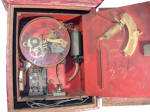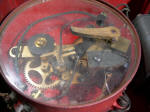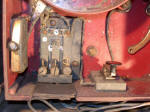|
How the Fire Alarm Telegraph Works |
||
|
Fire Alarm Telegraphs were really quite simple, however very cleaver in their workings. All fire alarm telegraphs worked in similar fashion, with a toothed wheel. Each wheel had a specific number of teeth according to the boxes location. The earliest boxes had a simple crank, which would be turned by the person reporting the fire. The teeth would raise and lower an arm, making an on and off connection. Just as with a telegraph, sending a signal with the location (the box number) of the box. The only problem with this was that some people would turn the crank to quickly or not enough times to be able to read the signal. This led to the development of the box seen below. The box had a simple pull down crank. When pulled, it would wind a motor inside, turning the toothed wheel at a set speed, which was always the same. This box also had a separate telegraph system which would allow the firemen with a key to the inner box, to call for additional help.
|
||
|
Click on the thumbnails below for a larger view. Also below that is a close up of the toothed wheel. This specific wheel is for box number 2321, originally located in the 23rd District at the corners of Mullanphy and 1st. Street. Notice the teeth are grouped in this fashion, 2-3-2-1, followed by a large space, or pause (the wheel turns clockwise). Just below this paragraph is a YouTube video of the box in operation.
|
||
|
|
||
Ditzel, Paul Fire Alarm!. Conway Enterprises, New Albany, IN. 1990. Gurka, Andrew. Firefighting Collectables. L-W Book Sales, Gas City, IN. 1994. Roncallo, Paul C. History of the Fire Alarm and Police Telegraph. M.T. Publishing, Evansville, IN. 2005. |
||



